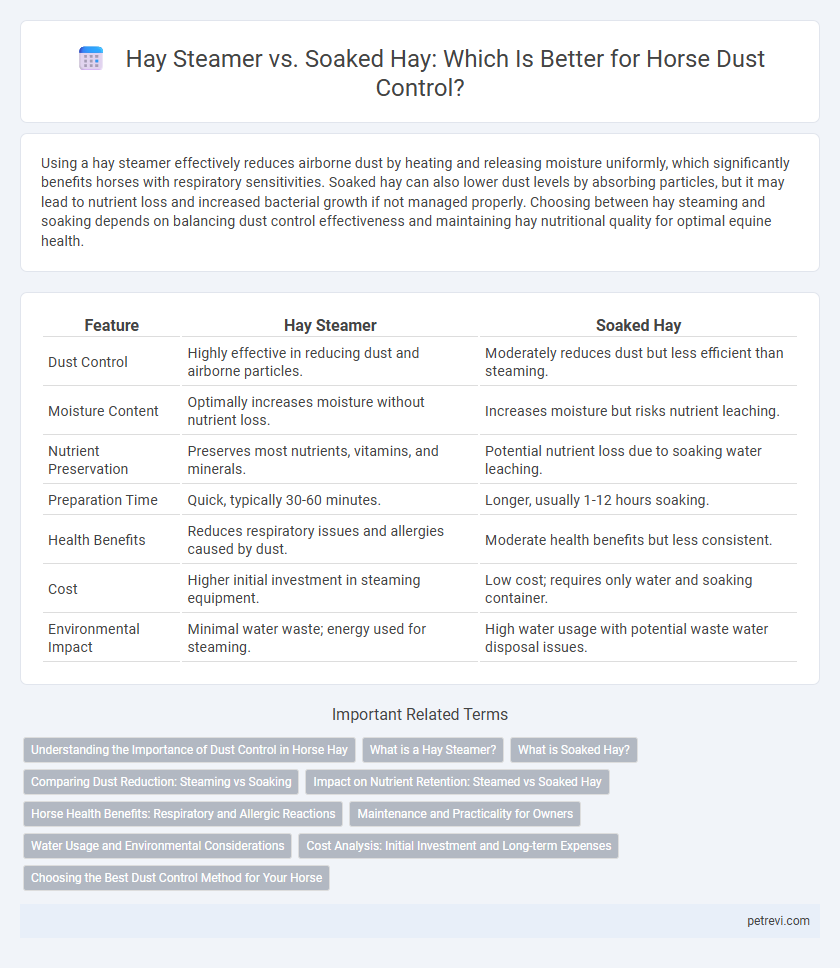Using a hay steamer effectively reduces airborne dust by heating and releasing moisture uniformly, which significantly benefits horses with respiratory sensitivities. Soaked hay can also lower dust levels by absorbing particles, but it may lead to nutrient loss and increased bacterial growth if not managed properly. Choosing between hay steaming and soaking depends on balancing dust control effectiveness and maintaining hay nutritional quality for optimal equine health.
Table of Comparison
| Feature | Hay Steamer | Soaked Hay |
|---|---|---|
| Dust Control | Highly effective in reducing dust and airborne particles. | Moderately reduces dust but less efficient than steaming. |
| Moisture Content | Optimally increases moisture without nutrient loss. | Increases moisture but risks nutrient leaching. |
| Nutrient Preservation | Preserves most nutrients, vitamins, and minerals. | Potential nutrient loss due to soaking water leaching. |
| Preparation Time | Quick, typically 30-60 minutes. | Longer, usually 1-12 hours soaking. |
| Health Benefits | Reduces respiratory issues and allergies caused by dust. | Moderate health benefits but less consistent. |
| Cost | Higher initial investment in steaming equipment. | Low cost; requires only water and soaking container. |
| Environmental Impact | Minimal water waste; energy used for steaming. | High water usage with potential waste water disposal issues. |
Understanding the Importance of Dust Control in Horse Hay
Effective dust control in horse hay is crucial to prevent respiratory issues such as heaves and allergic reactions in horses. Hay steamers reduce airborne dust by heating and moistening hay without nutrient loss, while soaked hay lowers dust but can leach valuable nutrients and promote bacterial growth. Choosing the appropriate method enhances respiratory health and maintains the nutritional quality essential for equine performance and well-being.
What is a Hay Steamer?
A hay steamer is a specialized device designed to heat and moisten hay, significantly reducing airborne dust and mold spores that can cause respiratory issues in horses. By gently steaming hay to temperatures around 100degC (212degF), it eliminates harmful bacteria, fungi, and dust particles without leaching nutrients. Hay steamers are increasingly preferred over soaking methods because they preserve essential vitamins and minerals while providing superior dust control for equine respiratory health.
What is Soaked Hay?
Soaked hay is hay that has been submerged in water for a period typically ranging from 30 minutes to several hours to reduce dust and allergens. This process helps to minimize respiratory issues in horses by softening the hay and washing away dust particles and mold spores. Compared to dry hay, soaked hay offers improved dust control but may lead to nutrient loss if soaked for too long.
Comparing Dust Reduction: Steaming vs Soaking
Steaming hay significantly reduces dust levels by killing mold spores and breaking down allergens, resulting in cleaner, safer feed for horses with respiratory issues. Soaked hay can lower dust by washing away surface dust particles but may increase bacterial growth if not used promptly. Studies show steaming achieves more consistent and effective dust control than soaking, promoting better respiratory health in sensitive horses.
Impact on Nutrient Retention: Steamed vs Soaked Hay
Steamed hay preserves more nutrients compared to soaked hay, as the steaming process prevents the leaching of water-soluble vitamins and minerals essential for equine health. Soaking hay can reduce crucial nutrients like calcium, potassium, and B vitamins by up to 50%, negatively impacting the horse's dietary intake. Steamed hay maintains higher levels of digestible energy and protein, supporting optimal nutrient retention while effectively controlling dust and allergens.
Horse Health Benefits: Respiratory and Allergic Reactions
Hay steamers significantly reduce airborne dust and mold spores, promoting better respiratory health and decreasing the risk of allergic reactions in horses. Soaked hay also lowers dust levels but can lead to nutrient loss and increased bacterial growth, which may compromise digestive health. Choosing hay steamers enhances overall horse well-being by maintaining hay nutrients while effectively minimizing respiratory irritants.
Maintenance and Practicality for Owners
Hay steamers effectively reduce dust and mold spores, improving respiratory health with minimal daily upkeep, requiring only water refills and occasional cleaning. Soaked hay controls dust by submerging hay overnight, but it demands more time, drainage space, and can lead to nutrient loss or spoilage if not managed properly. Owners seeking convenience and consistent dust reduction often prefer hay steamers for their ease of maintenance and practical daily use.
Water Usage and Environmental Considerations
Hay steamers use significantly less water--typically around 10-15 liters per session--compared to soaking hay, which can require up to 40-50 liters, reducing overall water consumption for dust control. Steamers effectively minimize airborne dust by humidifying hay without submerging it, preventing nutrient loss and limiting waste water discharge that can harm the environment. Soaked hay, while also reducing dust, creates large volumes of contaminated runoff that demand careful disposal to avoid soil and water pollution, making hay steaming a more eco-friendly alternative.
Cost Analysis: Initial Investment and Long-term Expenses
A hay steamer requires a higher initial investment cost, often ranging from $1,000 to $2,500 depending on capacity and features, whereas soaked hay only incurs minimal upfront costs such as water and labor. Long-term expenses for hay steamers include electricity, regular maintenance, and occasional parts replacement, which can add up but improve horse respiratory health and reduce waste. Soaking hay, while cheaper initially, leads to ongoing costs like water usage, increased labor time, and nutritional loss, potentially resulting in higher feed quantities and expenses over time.
Choosing the Best Dust Control Method for Your Horse
Choosing the best dust control method for your horse involves comparing hay steamers and soaked hay based on effectiveness and horse health. Hay steamers significantly reduce airborne dust and mold spores by heating and moistening hay without nutrient loss, promoting respiratory health. Soaked hay can lower dust but risks nutrient leaching and bacterial growth, making hay steaming a superior option for managing dust-related respiratory issues in horses.
Hay Steamer vs Soaked Hay for Horse Dust Control Infographic

 petrevi.com
petrevi.com